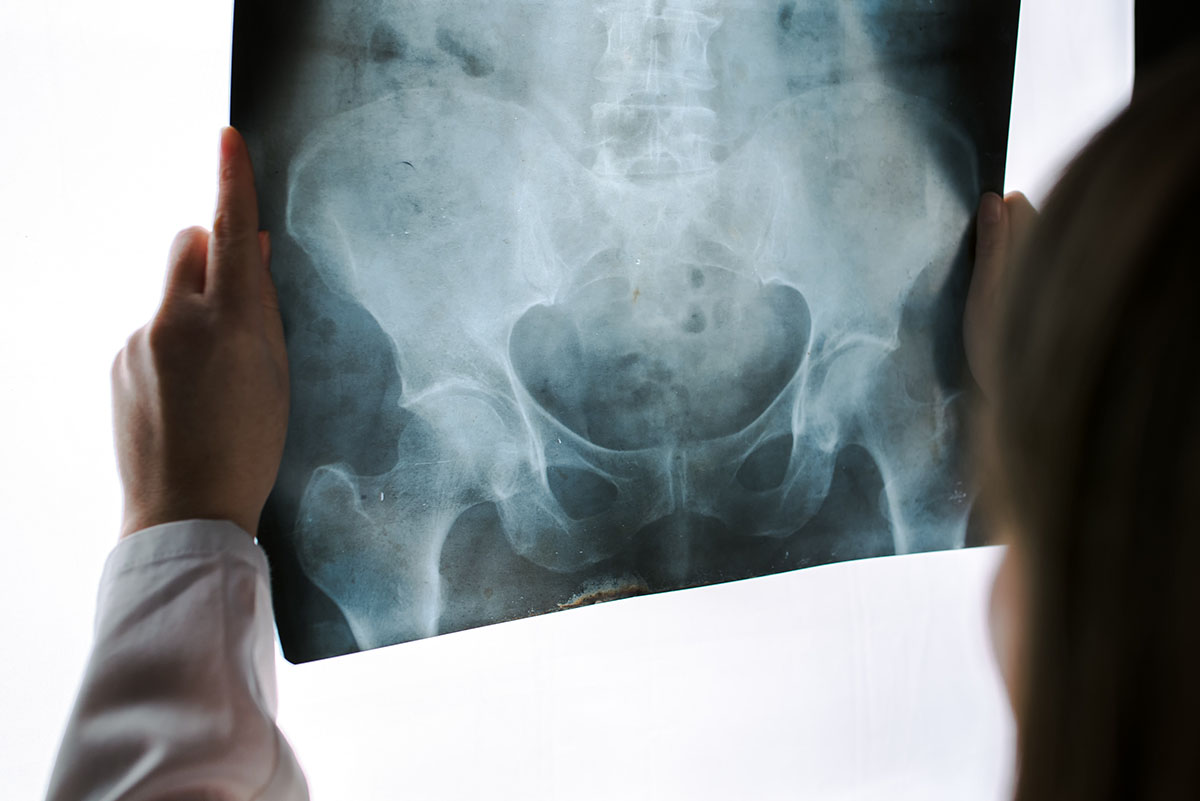What is Bone Cancer?
Cancer starts when cells begin to grow out of control. Cells in nearly any part of the body can become cancer and can then spread (metastasize) to other parts of the body.
Bone cancer is an uncommon type of cancer that begins when cells in the bone start to grow out of control. Bone cancer can begin in any bone in the body, but it most commonly affects the pelvis or the long bones in the arms and legs. Bone cancer is rare, making up less than 1% of all cancers. In fact, noncancerous bone tumors are much more common than cancerous ones. Cancer cells grow and harm normal tissue in the bones.
Different types of bone cancer affect various cells in the body, and understanding these differences is crucial for determining appropriate treatment and outlook. Bone tumors develop particularly during the rapid growth spurts that occur in young people during puberty, indicating a specific demographic at risk.
Cancers that form in the bone itself are called primary bone cancers. Many tumors that begin in organs or other parts of the body can spread to the bones, as well as other body parts. These growths are called secondary or metastatic bone cancers. This process, called metastatic cancer, involves cancer cells breaking away from the original tumor and spreading to other parts of the body. When cancer cells invade the bones, they can damage the normal bone tissue.
The American Cancer Society’s estimates for primary cancer of the bones and joints for 2024 are:
- About 3,970 new cases diagnosed
- About 2,050 deaths
Signs and Symptoms of Bone Cancer
Some people with bone cancer have no symptoms other than feeling a painless lump. For others, a variety of symptoms can develop. The most common symptoms of bone cancer include:
Bone Pain
Persistent or intermittent pain in the affected bone is often the earliest symptom. It may initially be mistaken for arthritis or growing pains in younger individuals. The pain tends to worsen over time, becoming more severe and constant, especially at night or during activity.
Swelling and Tenderness Near the Affected Area
As the tumor grows, it can cause visible swelling and tenderness around the area. This may be accompanied by a noticeable lump, especially in bones closer to the skin surface, such as the arms, legs, or ribs. The skin over the affected area might feel warm to the touch.
Weakened Bone, Leading to Fracture
Bone cancer can weaken the bone, making it more susceptible to fractures. These fractures can occur with minimal or no trauma, often termed as pathological fractures. Patients may experience sudden, sharp pain in the affected bone when a fracture occurs. It is essential to preserve healthy bone tissue to prevent issues like weakness and joint problems.
Fatigue
Generalized fatigue is a common symptom as the body expends energy fighting the cancer. This can lead to feelings of exhaustion that are not alleviated by rest, impacting daily activities and overall quality of life.
Unintended Weight Loss
Significant, unexplained weight loss can occur as a result of the cancer affecting the body’s metabolism. This is often a late symptom and may be associated with a more advanced stage of the disease.
Fever
A low-grade fever that persists without any apparent infection can be a sign of bone cancer. The fever may come and go, and is often accompanied by other systemic symptoms like night sweats.
Risk Factors for Bone Cancer
It’s not clear what causes bone cancer, but doctors have found certain factors are associated with an increased risk, including:
- Inherited genetic syndromes. Certain rare genetic syndromes passed through families increase the risk of bone cancer, including Li-Fraumeni syndrome and hereditary retinoblastoma.
- Paget’s disease of bone. Most commonly occurring in older adults, Paget’s disease of bone can increase the risk of bone cancer developing later.
- Radiation therapy for cancer. Exposure to large doses of radiation, such as those given during radiation therapy for cancer, increases the risk of bone cancer in the future.
The exact reasons why a person develops bone cancer are often unknown, though certain risk factors may increase the likelihood of developing the disease. It is important to distinguish between primary bone cancer, which originates in the bones, and secondary bone cancer, which occurs when cancer spreads to the bones from another part of the body.
What to Do if You Suspect You May Have Bone Cancer
Bone cancer is rare but very dangerous. If you suspect you or a loved one has bone cancer based upon your symptoms, it is imperative that you contact SCMSC or your primary physician to schedule a Bone Cancer screening.
Call SCMSC at (818) 900-6480 and tell them you are seeking a bone screening.
Bone Cancer Q & A
Bone cancer is a rare form of cancer. It can begin in any bone, but it is most commonly found in the pelvis or long bones in the arms and legs.
What is Bone Cancer vs. Metastatic Bone Cancer?
Bone cancer originates in bone tissue, while metastatic bone cancer spreads from elsewhere. CT scans and magnetic resonance imaging help differentiate sarcoma types. Specialized nursing care from Dr. Navid Eghbalieh request appointment alleviates pain associated with both cancer forms.
- Primary bone cancer develops in bone cells
- Metastatic bone cancer originates in other organs
- Advanced imaging techniques aid in accurate diagnosis
- Tailored pain management strategies improve quality of life
What is the Survival Rate of Bone Cancer?
The survival rate for bone cancer varies significantly based on the type, stage, and location of the cancer, as well as the patient’s age and overall health. For all types of primary bone cancer combined, the 5-year survival rate is around 66%. However, this statistic can vary:
- Osteosarcoma: The 5-year survival rate is about 60% to 70% for localized osteosarcoma, where the cancer has not spread beyond the bone or nearby tissues. If the cancer has spread to other parts of the body, the survival rate drops significantly.
- Ewing Sarcoma: This type also has a 5-year survival rate of about 70% for localized cases. However, when Ewing sarcoma has metastasized, the survival rate can be as low as 15% to 30%.
- Chondrosarcoma: This type generally has a better prognosis, with a 5-year survival rate ranging from 80% to 90% for low-grade tumors. High-grade tumors have a lower survival rate.
It’s essential to discuss individual prognosis with a healthcare provider, as survival rates are general estimates and can vary depending on many factors (Cancer Info & Resources).
How Aggressive is Bone Cancer?
Bone cancers are rare, but they are seen more frequently in children, teenagers, and young adults compared to older adults.
The aggressiveness of bone cancer varies depending on the type and stage of the disease. Some forms, like osteosarcoma and Ewing sarcoma, tend to be more aggressive, particularly in younger individuals. These cancers often grow rapidly and may spread (metastasize) to other parts of the body, making early detection and treatment crucial for better outcomes. Chondrosarcoma, another common type of bone cancer, can be less aggressive, but it still poses significant risks, especially if not treated promptly.
Ultimately, the aggressiveness of bone cancer is influenced by its type, location, and how quickly it is diagnosed and treated. It’s essential to work closely with a healthcare provider to understand the specific characteristics of the cancer and to develop an effective treatment plan.
Is Bone Cancer Curable?
The curability of bone cancer depends on various factors, including the type of bone cancer, the stage at which it is diagnosed, and how well it responds to treatment. Early-stage bone cancers, particularly those that are localized and have not spread, have a better prognosis and can often be treated successfully with a combination of surgery, chemotherapy, and sometimes radiation therapy.
It’s important to have an individualized treatment plan and discuss the prognosis with a healthcare provider to understand the specific circumstances and options available.
Treatment Options for Bone Cancer
Surgical removal is the most common treatment, but chemotherapy and radiation therapy also may be utilized. The decision to use surgery, chemotherapy or radiation therapy is based on the type of bone cancer being treated.
Dr. Navid Eghbalieh offers the following minimally invasive treatment options for bone cancer:
Minimally Invasive Treatments: Cryotherapy and Microwave Ablation
Minimally invasive treatments offer advanced options for bone cancer patients. Cryotherapy and microwave ablation target tumors in legs and arms precisely. These techniques, supported by the National Cancer Institute, reduce recovery time. Patients can request appointment with Dr. Navid Eghbalieh for more information.
- Cryotherapy freezes cancer cells, minimizing damage to surrounding tissue
- Microwave ablation uses heat to destroy tumors with pinpoint accuracy
- Both methods often require shorter hospital stays than traditional surgery
Remember, the right treatment depends on the type and stage of bone cancer. Always talk to your doctor about the best options for you.




